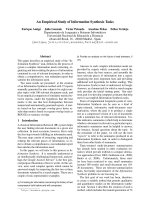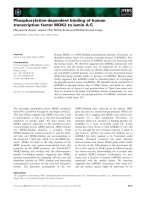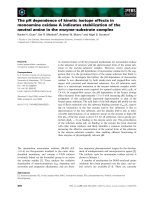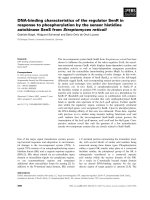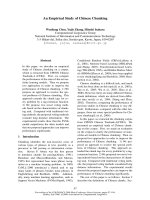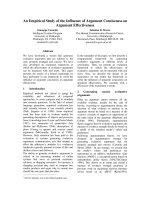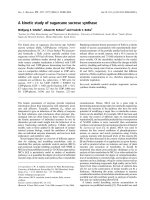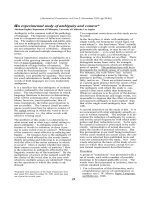Báo cáo khoa học: "Time Course Study of Cytokine mRNA Expression in LPS-Stimulated Porcine Alveolar Macrophages" pot
Bạn đang xem bản rút gọn của tài liệu. Xem và tải ngay bản đầy đủ của tài liệu tại đây (176.74 KB, 5 trang )
J O U R N A L O F
Veterinary
Science
J. Vet. Sci. (2002), 3(2), 97-101
ABSTRACT
6)
The kinetics of cytokine mRNA expression w as
studied in porcine alveolar macrophages using an
RT-PCR assay. The expression levels of IFN-
γ
, IL-2,
IL-4, IL-6, GM-CSF, IL-12 p35, and IL-12 p40 w ere
examined after 2, 4, 14, 24, 48, and 72 h of incubation
in unstimulated control and LPS-stimulated cells. The
expression contents of IFN-
γ
, IL-2, and IL-4 w ere not
detected in both unstimulated and LP S-stimulated
cells. On the other hand, the expression levels of IL-6,
GM-CSF, and IL-12 in LPS-stim ulated cells w ere
almost alw ays higher than those in control cells.
Among those cytokines, IL-6 exhibited the predominant
expression, and GM-CSF, IL-12 p40, and IL-12 p35
follow ed in the descending order. The times to reach
the peak expression levels for IL-6, and GM-CSF,
IL-12 p35, and IL-12 p40 w ere 14, and 24 h,
respectively. After reaching the peak expression
point, the expression levels of IL-6, GM-CSF, and
IL-12 p40 re duced to the baseline by 72 h after
stimulation, how ever, IL-12 p35 still kept a
substantial expression by the same time . This study
demonstrates that porcine alveolar macrophages
primarily respond to express IL-6, GM-CSF, and IL-12
by LPS-stimulation and have a cytokine-specific
expression profile during the stimulation time.
Key w ords:
Kinetics, porcine, cytokine expression, alveolar
macrophages, LPS-stimulation.
Introduction
Cytokines are important mediators of immune and
inflammatory responses in humans and animals. They
*
Corresponding author: Han Sang Yoo
Department of Infectious Diseases, College of Veterinary Medicine
and School of Agricultural Biotechnology, Seoul National University,
Suwon 441-744, Korea
Tel: 82-31-290-2737, E-mail:
Fax: 82-31-290-2737
regulate immunity at low concentrations and interact with
each other to keep the homeostasis in many physiological
responses[2]. They are classified into Th1 and Th2 types in
the human and mouse immune systems[8]. The Th1 type
cytokines, which are represented by IL-2, interferon-
γ
(IFN-
γ
), and IL-12, mediate cellular immune responses, whereas
the Th2 type cytokines, such as IL-4, IL-5, IL-6, and IL-10
are involved in antibody production and allergic responses[8].
It is generally known that cytokines, especially the
inflammatory cytokines, such as IL-1
β
and TNF-
α
, are
expressed for a short period, and the amounts expressed are
very low[1,2,9,17]. In contrast to human and mouse cytokines,
only a few reagents for porcine cytokines are available
either as proteins or antibodies from commercial companies.
For these reasons, several studies were conducted in vitro to
examine the expression levels or patterns of porcine
cytokines in mitogen-stimulated peripheral blood mononuclear
cells (PBMC) using a reverse-transcription polymerase chain
reaction (RT-PCR) assay[3,13,16]. Reddy et al[12] also determined
the cytokine expression responses and kinetics in lymphocytes
derived from lymph nodes that had been stimulated with
mitogens, such as lipopolysaccharide (LPS) and phytohe-
magglutinin (PHA).
Alveolar macrophages in the lung have important roles in
conducting the first defense against invading pathogens[11].
It has been known that they express inflammatory
cytokines that respond respiratory diseases[9]. In the present
study, we examined the porcine cytokine expression in
alveolar macrophages stimulated by LPS to determine the
time course patterns and the levels of the mRNA expression.
Materials and Methods
Experim ental Animals and Ce ll Preparations
Alveolar macrophages were obtained from three healthy
female pigs by means of lung lavage using sterile 1x PBS
as described elsewhere[1]. The cells were washed twice with
1x PBS by centrifugation at 300 x g for 10 min. The cells
in 25 cm2 tissue culture flasks were incubated for two hours
in a 5% CO2 humidified atmosphere, and unbound cells
were removed by washing twice the cells out with 1x PBS.
Time Course Study of Cytokine mRNA Expression in LPS-Stimulated Porcine
Alveolar Macrophages
In-Soo Choi, Na-Ri Shin, Sung-Jae Shin, Deog-Yong Lee, Young-Wook Cho and Han-Sang Yoo*
Department of Infectious Diseases, College of Veterinary Medicine and School of Agricultural Biotechnology,
Seoul National University, Suwon 441-744, Korea
Received Mar. 20, 2002 / Accepted May 17, 2002
98 In-Soo Choi, Na-Ri Shin, Sung-Jae Shin, Deog-Yong Lee, Young-Wook Cho and Han-Sang Yoo
L-glutamine-containing RPMI 1640 (Gibco BRL, Grand
Island, NY) supplemented with 10% fetal bovine serum
(FBS) and 50
㎍
/ml gentamicin was added to the cells.
Adherent cell populations were >95% macrophages and
>97% viable as determined by nonspecific esterase staining
and trypan blue dye exclusion, respectively. In this study,
the cells were classified into two groups, unstimulated
control and LPS (1
㎍
/ml)-stimulated cells. The cells were
cultured for 2, 4, 14, 24, 48, and 72 h, and total RNA was
prepared from the cells of the two groups. Peripheral blood
mononuclear cells (PBMC) were separated from whole blood
by centrifugation at 900 x g for 30 min in the presence of
Histopaque 1077 (Sigma, St. Louis, MO). PBMC were
washed twice with 1x PBS and then stimulated with
phytohemagglutinin (PHA) (2% v/v) for 1 day at 37
℃
in a
5% CO2 humidified atmosphere.
Preparation of RNA
Total RNA was extracted from PBMC and alveolar
macrophages at the end of each incubation time using Trizol
reagent (Gibco BRL) by following the manufacturer's
instruction. The RNA was precipitated with isopropanol
(Sigma, St. Louis, MO) and washed with 70% ethanol. The
RNA was then dissolved in 100
㎕
of DEPC-treated water
and treated with RNase-free DNase (Promega, Madison, WI)
for 30 min at 37
℃
. The DNase-treated RNA was again
purified with Trizol, and the purified RNA was dissolved in
50
㎕
of DEPC-treated water. The RNA extracted from
PBMC was used as the positive control sample for cytokine
gene amplification. The RNAs obtained from three pigs were
pooled into a single tube prior to the synthesis of cDNA. The
concentration of the combined RNA was determined by
measuring the optical density at 260 nm with a GeneQuant
II RNA/DNA Calculator (Pharmacia Biotech, Cambridge,
England).
Synthesis of cDNA
Synthesis of single-stranded cDNA was performed using
the Superscript Preamplification System for First Strand
cDNA Synthesis (Gibco BRL) according to the manufacturer's
instructions. Briefly, 5
㎍
of total RNA was used as a
template, and other components, such as 0.5
㎍
of
oligo(dT)12-18, 2
㎕
of 10x PCR buffer, 2
㎕
of 25 mM MgCl2,
1
㎕
of 10 mM dNTP mix, 2
㎕
of 0.1 M DTT, and 200 units
of Superscript II RT were added to the reaction tube
containing the RNA. cDNA synthesis was conducted at 42
℃
for 50 min, and the reaction was terminated by incubating
the reaction tube for 15 min at 70
℃
. The residual RNA was
digested by adding 2 units of RNase H and incubating the
reaction tube for 20 min at 37
℃
. The cDNA was stored at
-20
℃
and used as a template for amplification of the
cytokine genes by PCR.
Amplification of Cytokine Genes by PCR
Cyclophilin A and cytokine-specific primer sets (Table 1)
were designed and synthesized based on the cDNA
sequences obtained from the GenBank database. The
cyclophilin A gene was amplified under the following PCR
conditions for 30 cycles; 94
℃
for 30 s, 55
℃
for 30 s, and 7
2
℃
for 30 s. All of the cytokine genes examined in this
study were amplified for 40 cycles by PCR. The IFN-
γ
gene
was amplified under the following PCR conditions; 94
℃
for
30 s, 50
℃
for 30 s, and 72
℃
for 45 s. The IL-2 gene was
amplified under the following PCR conditions; 94
℃
for 30 s,
Table 1.
Primer sets used to amplify cytokine genes, their oligonucleotide sequences, the sizes of PCR products, and
GenBank accession numbers
Primer sets Primer sequences
Sizes of PCR
products(bp)
GenBank
accession
IFN-
γ
IL-2
IL-4
IL-6
GM-CSF
IL-12 p35
IL-12 p40
Cyclophilin A
5'-ATGAGTTATACAACTTATTTCTTAG-3'
5'-TTATTTTGATGCTCTCTGGCC-3'
5'-ATGTATAAGATGCAGCTCTTG-3'
5'-TCAAGTCAGTGTTGAGTAGATG-3'
5'-ATGGGTCTCACCTCCCAACTG-3'
5'-TCAACACTTTGAGTATTTCTCCTTC-3'
5'-ATGAACTCCCTCTCCACAAGC-3'
5'-CTACATTATCCGAATGGCCCTC-3'
5'-ATGTGGCTGCAGAACCTGC-3'
5'-TTACTTTTTGACTGGCCCCCAG-3'
5'-ATGTGTCCGCTGCGCAAC-3'
5'-TTAGGAAGAATTCAGATAGCTC-3'
5'-ATGCACCTTCAGCAGCTGGTTG-3'
5'-CTAATTGCAGGACACAGATGC-3'
5'-ATGGTTAACCCCACCGTCTTC-3'
5'-GTTTGCCATCCAACCACTCAG-3'
501
465
402
639
435
669
975
376
S63967
X56750
X68330
M80258
U67175
L35765
U08317
F14571
Time Course Study of Cytokine mRNA Expression in LPS-Stimulated Porcine Alveolar Macrophages 99
53
℃
for 30 s, and 72
℃
for 45 s. The IL-4 gene was
amplified under the following PCR conditions; 94
℃
for 30 s,
55
℃
for 30 s, and 72
℃
for 40 s. The IL-6 gene was
amplified in the following PCR conditions; 94
℃
for 30 s, 5
3
℃
for 30 s, and 72
℃
for 45 s. The GM-CSF gene was
amplified under the following PCR conditions; 94
℃
for 30 s,
55
℃
for 30 s, and 72
℃
for 40 s. The IL-12 p35 gene was
amplified under the following PCR conditions; 94
℃
for 30 s,
50
℃
for 30 s, and 72
℃
for 45 s. The IL-12 p40 gene was
amplified under the following PCR conditions; 94
℃
for 30 s,
58
℃
for 30 s, and 72
℃
for 60 s. The PCR products were
analyzed by electrophoresis in 1.5% agarose gels. The
gene-specific DNA bands were detected under ultraviolet
light following the staining of the gels with ethidium
bromide. The densities of DNA bands were measured using
the Gel Documentation System (Bio-Rad, Hercules, CA).
Normalization of Cytokine Gene Expression
Because cyclophilin A was used as the house-keeping
gene in this study, the expression level of each cytokine
gene was normalized against that of the cyclophilin A gene.
The final expression of each cytokine gene was determined
by subtracting the expression level of a cytokine in control
cells from that of it in LPS-stimulated cells.
Results
Specificity of PCR Reactions
PCR reactions were performed under each gene-specific
condition to amplify 7 kinds of cytokines, IFN-
γ
, IL-2, IL-4,
IL-6, GM-CSF, IL-12 p35, and IL-12 p40, and cyclophilin A
with cDNA prepared from PHA-stimulated PBMC. The
electrophoresed PCR products showed the correct sizes of
the amplified gene-specific DNA, including IFN-
γ
(501 bp),
IL-2 (465 bp), IL-4 (402 bp), IL-6 (639 bp), GM-CSF (435
bp), IL-12 p35 (669 bp), IL-12 p40 (975 bp), and cyclophilin
A (376 bp) (Fig. 1). This result demonstrated that the PCR
conditions used in this study were suitable for the
amplification of cytokines and cyclophilin A genes.
fig. 1.
Specificity of PCR. Gene specific DNA bands were
identified by analyzing the PCR products in 1.5% agarose
gel. M, DNA marker; Lane 1, IFN-
γ
(501 bp); Lane 2, IL-2
(465 bp); Lane 3, IL-4 (402 bp); Lane 4, IL-6 (639 bp); Lane
5, GM-CSF (435 bp); Lane 6, IL-12 p35 (669 bp); Lane 7,
IL-12 p40 (975 bp); Lane 8, cyclophilin A (376 bp).
Expression Profile of IFN-
γ
, IL-2, and IL-4
Although IFN-
γ
, IL-2, and IL-4 expression was evident
in PHA-stimulated PBMC as shown in fig. 1, their
expression was not detected in LPS-stimulated alveolar
macrophages during the entire stimulation period (data not
shown). The result obtained in this study may be
reasonable, because IFN-
γ
, IL-2, and IL-4 are typically
produced from T lymphocytes.
Kinetics of IL-6, GM-CSF, and IL-12 Expression
The expression levels of all cytokines examined in this
study were determined in three different stages, such as the
early (2 and 4 h), the intermediate (14 and 24 h), and the
late (48 and 72 h) periods after LPS-stimulation. There was
a slight increase of IL-6 expression in the early stage (2 and
4 h) of LPS-stimulation (fig. 2A). After the early period of
induction, IL-6 expression was so dramatically increased in
the intermediate stage of stimulation that it reached a peak
point at 14 h. A substantially high expression of IL-6 was
still observed until 24 h of stimulation. However, IL-6
expression was sharply decreased almost to the base level in
the late period (48 and 72 h) of stimulation (fig. 2A).
A little increase of GM-CSF expression was observed in
the early period, and then the expression was descended to
the base line at 14 h of LPS-stimulation (fig. 2B). The
highest expression of GM-CSF was detected at 24 h of
stimulation. In the late period of stimulation, GM-CSF
expression was continually reduced and reached the base
line at 72 h (fig. 2B). Compared to the expression period of
IL-6, a high expression of GM-CSF occurred for a short
period.
Since IL-12 is a heterodimer cytokine composed of two
subunits of p35 and p40, we separately examined the
expression kinetics of two subunits. The whole expression
levels of both IL-12 p35 and IL-12 p40 were lower than
those of IL-6 and GM-CSF. Both IL-12 subunits
demonstrated the peak expression levels at 24 h (fig. 2C and
D). However, the expression patterns of both subunits were
different. In the case of IL-12 p35 subunit, the expression
contents in the late period (48 and 72 h) of stimulation were
almost the same as the maximum level determined at 24 h
(fig. 2C). In contrast, the expression of IL-12 p40 subunit
was rapidly decreased after 24 h of stimulation, and lower
than in control cells at 72 h (fig. 2D).
Discussion
Cytokines have the ability to regulate a broad range of
immune and inflammatory responses, including humoral
and cell-mediated immune reactions[15]. It has been suggested
that the onset of the respiratory diseases or endotoxemia
caused by Gram-negative bacterial infection is induced by
the expression of proinflammatory cytokines, such as tumor
necrosis factor (TNF), interleukin-1 (IL-1), and IL-6[6,9,10].
Although several studies have been conducted to examine
the patterns or kinetics of porcine cytokine gene expression
in PBMC or leukocytes[3,12,13,16], there is presently no study
100 In-Soo Choi, Na-Ri Shin, Sung-Jae Shin, Deog-Yong Lee, Young-Wook Cho and Han-Sang Yoo
of the kinetics of porcine cytokine mRNA expression in
alveolar macrophages. In this study, we examined seven
porcine cytokine expression levels over a time course in
LPS- stimulated alveolar macrophages.
Two distinctive expression patterns of the porcine cytokines
were observed in alveolar macrophages. First, the expression
of porcine IFN-
γ
, IL-2, and IL-4 was not detected in either
LPS-stimulated or control cells. In Con A-stimulated porcine
PBMC, the mRNA expression levels of IFN-
γ
, IL-2, and
IL-4 peaked after 24 h of stimulation[3]. However, our study
using alveolar macrophages that were stimulated by LPS
demonstrated no expression of them. These differences in
cytokine gene expression are attributable to the difference of
cell types. Second, IL-6, GM-CSF, IL-12 p35, and IL-12 p40
expression levels were almost always higher in LPS-
stimulated alveolar macrophages than in unstimulated
controls. Among these cytokines, IL-6 showed the highest
expression. Therefore, it is confirmed that bacterial
endotoxin is an effective stimulator for production of these
inflammatory cytokines in alveolar macrophages.
The facts showing the definite augmentation of IL-6 and
IL-12 expression demonstrated in this study were similar to
other data observed in LPS-stimulated porcine or human
alveolar macrophages[4,5,7,14]. It is also known that IL-6 level
is increased in the sera of pigs that are infected with
Actinobacillus pleuropneumoniae, one of the most potent
respiratory disease-inducing Gram-negative bacteria of
pigs[6]. The highest expression of IL-6 in the LPS-stimulated
porcine alveolar macrophages was demonstrated after 6 h of
stimulation[14]. In our study, however, the peak expression of
IL-6 occurred at 14 h of incubation. On the other hand, in
kinetics studies of IL-12 p35 and IL-12 p40 expression in
LPS-stimulated porcine alveolar macrophages, the highest
IL-12 p35 and IL-12 p40 expression levels were detected
after 2 and 18 h of stimulation, respectively[4]. However, our
study showed the highest expression of both IL-12 p35 and
IL-12 p40 after 24 h of stimulation. The possible reason for
these differences even using the same cells and stimulating
fig. 2.
Kinetics of IL-6 (A), GM-CSF (B), IL-12 p35 (C), and IL-12 p40 (D) mRNA expression. Cytokine gene expression levels
were determined in LPS-stimulated alveolar macrophages after 2, 4, 14, 24, 48, and 72 h of incubation. To normalize the
expression levels of each cytokine, the ratios of each cytokine/cyclophilin A were calculated, and the ratios of
cytokine/cyclophilin A in the control were subtracted from those in LPS-stimulated cells. The subtracted ratios were plotted
against the stimulation times.
Time Course Study of Cytokine mRNA Expression in LPS-Stimulated Porcine Alveolar Macrophages 101
reagent would be because of the different experimental
methods employed, such as a northern blotting and an
RT-PCR.
In conclusion, the results obtained in this study indicate
that each porcine cytokine has its own expression pattern in
alveolar macrophages depending upon the stimulator and
the length of stimulation. The increased expression of IL-6
and IL-12 in LPS-treated alveolar macrophages especially
suggests that the respiratory disease-inducing Gram-negative
bacterial infections stimulate expression of both cytokines in
vivo. Taken together, the mRNA expression profiles of IL-6,
IL-12, and other cytokines examined in this study would be
useful references for the diagnosis of bacterial respiratory
diseases in pigs.
Acknowledgements
This study was supported by a grant from the Brain
Korea 21 project, a grant from Agricultural Research
Planning Center (299100-3), and a grant from the Research
Institute for Veterinary Science, College of Veterinary
Medicine, Seoul National University, Korea.
References
1.
Baarsch, M. J., Wannemuehler, M. J., Molitor, T.
W., and Murtaugh, M. P.
Detection of tumor necrosis
factor
α
from porcine alveolar macrophages using an
L929 fibroblast bioassay. J. Immunol. Methods. 1991,
140
, 15-22.
2.
Balkw ill, F. R., and Burke, F.
The cytokine network.
Immunol. Today. 1989,
10
, 299-304.
3.
Dozois, C. M., Oswald, E., Gautier, N. Serthelon,
J P., Fairbrother, J. M., and Osw ald, I. P.
A reverse
transcription-polymerase chain reaction method t
o
a nalyze porcine cytokine gen e expression. Vet . Immunol.
Im munopath ol. 1997,
58
, 287-300.
4.
F oss, D . L., a nd Mu rtaugh, M. P .
Molecu lar clonin g
a nd m RNA expression of porcine in ter leuk in -12. Vet.
Im munol. Immunopath ol. 1997,
57
, 121-134.
5.
F oss, D. L., Zilliox, M. J ., a n d Mu rtau g h , M. P .
Differentia l regu lation of m a cropha ge interleuk in -1
(IL-1), IL-12, a n d CD 80-CD86 by two bacterial toxin s.
In fect . Im m u n. 1999,
67
, 5275-5281.
6.
F ossum , C., Wa ttrang, E., F u x ler, L., J ensen, K. T.,
a n d Wa llg re n , P .
E valu ation of various cytokin es (IL-6,
IF N -
α
, IFN-
γ
, TNF-
α
) as markers for acute bacterial
infection in swine a possible role for serum interleukin -6.
Vet. Im m u nol. Im m unopat hol. 1998,
64
, 161-172.
7.
Isler, P ., d e Roc h em onte ix , B . G., S o n geo n , F .,
B oehringer, N., a n d Nico d, L. P .
Interleuk in-12
pr oduction by h u m a n a lveola r m acrophages is controlled
by th e autocrin e production of interleukin-10. Am . J.
Resp ir. Cell Mol. Biol. 1999,
20
, 270-278.
8.
Mo smann, T. R., a n d Sad, S .
Th e exp andin g u n iver se
of T-cell su bsets: Th1, Th 2 and m or e. Im m unol. Toda y.
1996,
17
, 138-146.
9.
Mu rtau g h , M. P ., Baarsch , M. J ., Zh ou, Y.,
S ca murra, R. W., a n d Lin, G.
In flam m atory cytok in es
in anim a l health and disea se. Vet. Im m u n ol.
Im munopat hol. 1996,
54
, 45-55.
10.
N akagaw a, M., O ono, H ., and Nish io, A.
E nhanced
pr oduction of IL-1
β
and IL-6 following endotoxin
challenge in rats with dietary magnesium deficiency. J.
Vet. Med. Sci. 2001,
63
, 467-469.
11.
Pabst, R.
The respiratory immune system of pigs. Vet.
Immunol. Immunopathol. 1996,
54
, 191-195.
12.
Reddy, N. R. J., Borgs, P., and Wilkie, B. N.
Cytokine mRNA expression in leukocytes of efferent
lymph from stimulated lymph nodes in pigs. Vet.
Immunol. Immunopathol. 2000,
74
, 31-46.
13.
Verfaillie, T., C
o
x , E., To , L. T., Vanro m pay, D .,
B ouchau t, H., Buys , N ., a n d Go d dee ris, B . M.
Com parative a nalysis of porcine cytok in e production by
mRNA and protein detection. Vet. Immunol. Im m u n opat hol.
2001,
81
, 97-112.
14.
Vézina, S . A., Roberge, D., F ourn ier, M., Dea , S,
Oth, D ., a n d Arch a m bault, D.
Clon ing of porcin e
cytokine-specific cD N As and detection of porcin e tu m or
n ecrosis fa ctor a lph a , inter leu k in 6 (IL-6), an d IL-1
β
gene expression by reverse transcription PCR and
chemiluminescence hybridization. Clin. Diag. Lab. Immunol.
1995,
2
, 665-671.
15.
Wood, P.R., and Seow , H F.
T cell cytokines and
disease prevention. Vet. Immunol. Immunopat
h
ol. 1996,
54
, 33-44.
16.
Yancy, H., Ayers, S. L., Farrell, D. E., Day, A., and
Myers, M.
Differential cytokine mRNA expression in
swine whole blood and peripheral blood mononuclear
cell cultures. Vet. Immunol. Immunopathol. 2001,
79
,
41-52.
17.
Yoo, H. S., Mahesw aran, S. K., Lin, G., Tow nsend,
E. L., and Am es, T. R.
Induction of inflammatory
cytokines in bovi
ne alveola r m a cr ophages f
o
llowing
stimulation with Pasteurella haemolytica lipopoly-
saccharide. Infect. Immun. 1995,
63
, 381-388.
